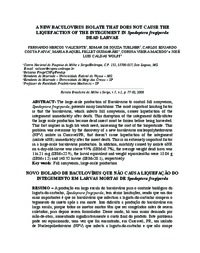A new baculovirus isolate that does not cause the liquefaction of the integument in Spodoptera frugiperda dead larvae.
A new baculovirus isolate that does not cause the liquefaction of the integument in Spodoptera frugiperda dead larvae.
Author(s): VALICENTE, F. H.; TUELHER, E. de S.; PAIVA, C. E. C.; GUIMARÃES, M. R. F.; MACEDO, C. V.; WOLFF, L. C.
Summary: The large-scale production of Baculovirus to control fall armyworm, Spodoptera frugiperda, presents many limitations. The most important limiting factor is that the baculovirus, which infects fall armyworm, causes liquefaction of the integument immediately after death. This disruption of the integument difficultates the large scale production because dead insect must be frozen before being harvested. This fact implies in high lab work need, increasing the cost of the biopesticide. This problem was overcome by the discovery of a new baculovirus nucleopolyhedrovirus (NPV) isolate in Cascavel/PR, that doesn?t cause liquefaction of the integument (isolate 6NR) immediately after the insect death. This is an extremely important factor in a large-scale baculovirus production. In addition, mortality caused by isolate 6NR on 6-day-old-larvae was above 93% (SEM=0.7%), the average weight dead larva was 116.21 mg (SEM=22.9), the larval equivalent and weight equivalent/ha were 15.04 g (SEM=1.2) and 140.32 larvae (SEM=20.1), respectively.
Publication year: 2008
Types of publication: Journal article
Unit: Embrapa Maize & Sorghum
Keywords: Fall armyworm, Large-scale production
Observation
Some of Embrapa's publications are published as ePub files. To read them, use or download one of the following free software options to your computer or mobile device. Android: Google Play Books; IOS: iBooks; Windows and Linux: Calibre.
Access other publications
Access the Agricultural Research Database (BDPA) to consult Embrapa's full library collection and records.
Visit Embrapa Bookstore to purchase books and other publications sold by Embrapa.

